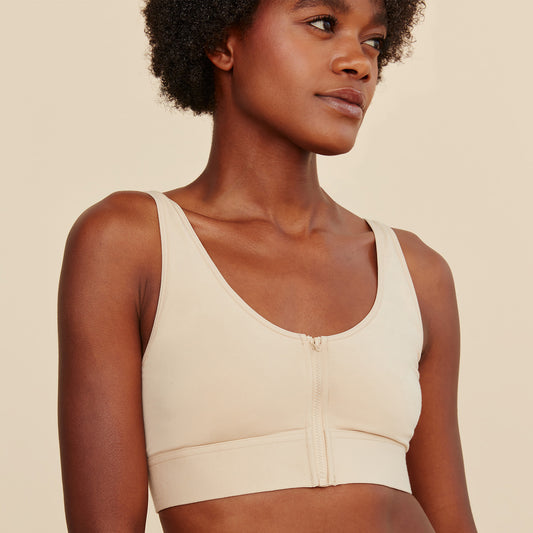The surgical removal of one or both breasts through mastectomy produces major life changes to treat or stop breast cancer manifestations. The medical necessity of mastectomy requires doctors to perform this surgery while patients face significant physical consequences along with emotional suffering. Patients achieve better safety with confidence throughout their experience when they grasp the surgical details and healing process while learning about their reconstruction choices.
The guide explains breast surgery varieties and reconstructive methods together with post-treatment care protocols as well as examines treatment of sensitive skin and menopause symptoms and emotional support requirements during patient recovery.
What is a Mastectomy?
Mastectomy is the surgical removal of breast tissue. It is performed for various reasons, including breast cancer treatment, risk reduction in high-risk individuals, and management of other breast conditions.
Types of Mastectomy
Medically recommended breast surgery depends upon both the patient's health risk factors and medical diagnosis and personal choice of treatment options.
1. Total (Simple) Mastectomy
The operation takes out the whole breast tissue together with the nipple and areola yet leaves behind lymph nodes and chest muscles.
2. Radical Mastectomy
The surgical intervention entails removing the breast tissue together with chest muscles as well as lymph nodes. Total mastectomy provides limited use in current patient care because cancer spread is required at widespread levels.
3. Modified Radical Mastectomy
This procedure takes away the breast tissue and lymph nodes though it retains the chest muscles. Invasive breast cancer makes up the primary indication for employing this surgical procedure.
4. Skin-Sparing Mastectomy
The procedure maintains the breast skin fairly intact which enables right-away reconstructive procedures.
5. Nipple-Sparing Mastectomy
The surgical procedure both keeps the breast skin alongside the nipple-areola complex section and removes all breast tissue. The surgery presents itself as an alternative for women choosing preventive mastectomy.
Breast Reconstruction After Mastectomy
The process of healing for numerous women includes breast reconstruction as an essential component. There are several options available:
1. Implant-Based Reconstruction
People use silicone or saline implants to reconstruct breast shape. The surgical procedure involves two distinct phases because patients first require tissue expansion and then receive placement of implants.
2. Autologous (Flap) Reconstruction
The patient's body tissue is taken from their abdominal area or from their back or thighs to build a new breast structure. The DIEP flap together with TRAM flap stand out among other techniques used for breast reconstruction.
3. Combination Reconstruction
Recovery combines implant surgery with autologous tissue procedures to achieve better natural breast appearance and sensation.
Women make different choices after losing their breasts and select either wearing prosthetic devices or remaining without breast restoration. The selection between different options should match an individual's needs and medical condition along with their way of life.
Post-Mastectomy Care and Recovery
Complete recovery following mastectomy surgery demands dual medical care and emotional nursing. Healing processes alongside quality of life improvement become better with appropriate medical care.
1. Managing Pain & Sensitivity
Post-surgical discomfort is common. To manage pain and sensitivities along with discomfort patients should use pain relievers combined with cold treatments while performing gentle stretching exercises. Sensitized skin finds relief from irritation when people wear smooth clothes without seams.
2. Caring for Sensitive Skin
The skin becomes more sensitive after mastectomy because of surgical procedures together with radiation exposure. To minimize irritation you should apply fragrance-free moisturizers together with loose bra underwear and UV-blocking measures.
3. Dealing with Menopause Symptoms
The hormonal balance disruption following mastectomy surgery affects women who receive hormone therapy by activating unpleasant menopausal symptoms which include night sweats and hot flashes along with mood swings. Effective control and management of these symptoms requires proper dietary habits combined with hydration levels and also needs medical assistance.
4. Emotional Healing & Mental Health
A mastectomy procedure tends to negatively affect both physical appearance and self-perception. The exploration of support groups together with therapy and counseling sessions alleviates emotional distress. Recovery requires open communication with close family members to develop successfully.
Choosing the Right Post-Mastectomy Products
After surgery, selecting the right products can improve comfort and confidence.
-
Front Closure Bras: Easy to wear, provide gentle compression, and support healing.
-
Post-Mastectomy Clothing: Soft fabrics that reduce friction and accommodate post-surgery changes.
-
Breast Prostheses: An alternative to reconstruction for a natural shape.
For high-quality post-mastectomy bras and recovery wear, explore trusted brands specializing in comfortable and supportive designs.
Why Understanding Mastectomy Matters
Empowers women to make informed decisions about surgery and recovery.
Encourages self-care by addressing sensitive skin, menopause, and emotional well-being.
Provides options for reconstruction, prostheses, and lifestyle adjustments.
Supports mental health through awareness of the psychological effects of mastectomy.
Conclusion: Moving Forward with Strength
Patients can complete their mastectomy journey successfully by obtaining proper critical knowledge and support together with useful resources. The decision to select reconstruction or use prostheses or choose a flat recovery exists for every woman to achieve comfort next to confidence and complete control during her healing process.
Learn everything about post-mastectomy treatment by discovering recovery products from expert brands who specialize in reconstructive clothing options.
Share your mastectomy experiences and questions to help others going through similar situations.


























